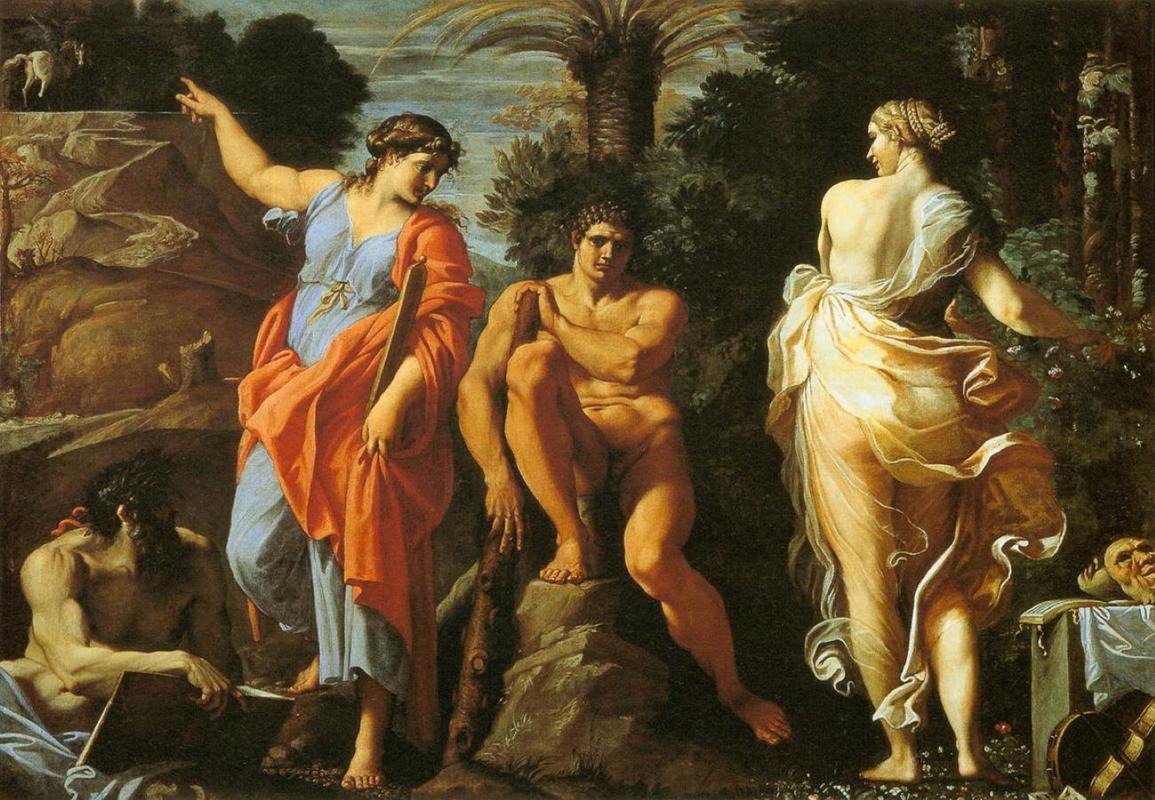More about The Choice of Hercules

Sr. Contributor
Most people have tiny angels and demons on their shoulders, but in this painting by Annibale Carracci Hercules has two gorgeous women to help him through his biggest moral crossroads.
The two women are called Vice and Virtue, and you can probably guess which one Hercules ends up choosing. If you’re familiar at all with his legends, you know Hercules tries to lead a virtuous life. But in Greek mythology, even the best laid plans turn murderous and terrible when vengeful gods get involved. His future misfortunes aside, this particular scene is rather famous as a parable, the adolescent hero choosing the path of his life as he sets out on his own.
Beyond their beauty, both of the women have tools in their arsenal to try and convince Hercules to follow them. In the oldest version, Vice goes the temptress route by offering indulgent pleasures like food and wine. She also caters to Hercules' lust, mentioning not just beautiful women but also men. It might be lesser known in modern retellings of his myth, but Hercules’ appreciation of beauty wasn’t confined to a single gender. For example, when Hercules joined the Argonaut crew he brought his lover Hylas along with him.
Virtue also has a long list to present, but instead of enticing pleasures, she’s got prerequisites that Hercules has to accomplish in order to gain the favor of the gods and mortals alike. She’s honest with him, not mincing words about how trying to lead a good life will be incredibly difficult for the young hero.
As far as Hercules’ response goes, the oldest version doesn’t tell us how he reacted to either of them. It only implies that he went with Virtue in the end. The version in Philostratus' Life of Apollonius of Tyana likely had the most relevance to Carracci since its Latin translation was published there in Italy in 1501. In this story, Hercules’ choice is mentioned, but the descriptions of Vice and Virtue vary from their representations here. Carracci seems to have applied a Renaissance lens to the women as a way of making the two choices have a more modern relevance to his audience.
Here, Virtue is portrayed the pursuit of fine arts or science. The man reading the book with a laurel wreath on his head is a representation of “poeta laureatus” which was a poet employed by the government. Pegasus, up in the corner Virtue is pointing to, implies that the long road of hard work would lead Hercules to the Muses on Mount Helicon. Virtue is described in Philostratus' Life of Apollonius of Tyana as worn down from years of toil, and she's shown dressed in only the plainest clothes, and without shoes.
Carracci’s Vice, on the other hand, looks like she’s trying to lure Hercules into the forest for a tryst. The playing cards, tambourine, theatrical masks, and sheet music as weren’t in Philostratus’ original text, but give you an idea of how people viewed music and theater at the time. As for Hercules' choice, the whole parable is spoken of in past tense as an example of how difficult it is to be an honorable man like Hercules and willingly choose hardship.
Sources
- "Hylas in Greek Mythology." Greek Legends and Myths. Accessed June 06, 2021. https://www.greeklegendsandmyths.com/hylas.html.
Featured Content
Here is what Wikipedia says about The Choice of Hercules (Carracci)
The Choice of Hercules is a painting by the Italian Baroque painter Annibale Carracci. Dating from 1596, it is housed in the Capodimonte Gallery of Naples. The subject is the Choice of Hercules.
Carracci, who was in Rome from the late 1595 or early 1596, was commissioned this work by Cardinal Odoardo Farnese for the ceiling of his camerino in his family's palace. In 1662 it was moved to the Farnese ducal seat in Parma. The work is considered one of Carracci's masterworks for its balanced rendering of a poetical ideal, graphically influenced by the artist's contact with Michelangelo's Sistine Chapel frescoes and Rome's classical remains, such as the Farnese Hercules or the Laocoön group.
A vigorous and plastic Hercules is depicted with two women flanking him, who represent the opposite destinies which life could reserve him: to his right Virtue is calling him to the hardest path leading to glory through hardship, while on his left, a woman with worldly pleasures, the easier path, is enticing him to vice.
Behind Hercules is a palm, which, through the leaves and the branches (a symbol of military victory and fame), hints to Hercules' future heroic life.
At the top of the hardest path is Hercules reward, Pegasus.
Check out the full Wikipedia article about The Choice of Hercules (Carracci)












